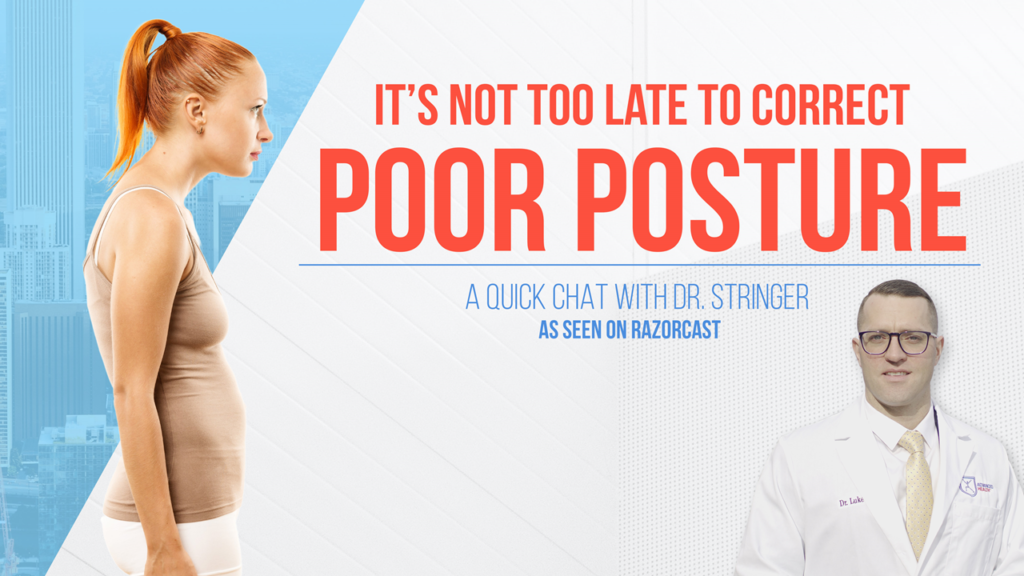
Posture is a window into your health. If you follow these proactive steps, you should be able to correct your poor posture and learn how to maintain good posture.
Adjust Your Workstation. Ergonomics are really important. If we’re in a corporate environment, typically, we’re required to sit for extended periods of time. Particularly during the pandemic, not many people have been able to go into their offices. Offices are typically designed around ergonomics with good working spaces. Many people, if they’re in the corporate environment, spent the last 24 months working from home, typically, in a non-ergonomically sound environment.
Try a Standing Desk. We stress in our office that motion is lotion. You’ve got to move. So, if you’re sitting, you’ve got to start standing and using a proper stand-up desk. The rule of thumb is 20 to 30 minutes sitting, 30 to 40 minutes standing.
A lot of the posture muscles that sit deep in your neck, deep between the shoulder blades, pick up on movement. So, if we are not moving, if we are sitting 8 to 10 hours a day, obviously, those muscles are going to get weak and lazy. That creates compensation issues, that upper and lower cross syndrome which just essentially means the big muscles in the upper back or the lower back get dominant and little muscles tend to switch off, and that creates poor posture.
Break up your workday. Between breakfast and lunch, lunch and dinner, spend five to 10 minutes taking some posture breaks, engaging those muscles that sit deep in your neck, between your shoulder blades, and deep between your pelvis. Simple, basic exercises that you can do sitting or standing at your desk are going to really activate those posture muscles. It’s all about being proactive, not reactive.
Apply the Four Finger Rule. We use a four finger rule in our office. If we ever see anyone on the phone or reading a book while they’re waiting for treatment, they’ve got a to make sure their chin is four fingers from their chest. You can do this quickly yourself. Grab your hand, open the palm, and you’re going to put your little finger right in that little indent in your chest. And then you’re going to bring your chin down until you hit the top of that fourth finger. That’s as much flexion that we should have in the cervical spine in the neck. So, if you’re on your tablet, or you’re typing, you’re looking at the keyboard, you’re working, or you’re reading a book, four fingers chin to chest is the absolute maximum amount of flexion that we should see in the cervical spine.
Get a Detailed Analysis of Your Posture. See a chiropractor who will conduct a detailed analysis of your posture. If we use our clinic for example, you’ll come in and sit down with the doctor who will perform a detailed history, a physical examination, an orthopedic examination, and a neurological evaluation. We’ll take a posture picture with a really cool piece of equipment that we have that will do some analysis from normal to where you are. And to see is to know, so we’ll take x-rays. Do we have that forward head shift? Do we have a reduction in the curve? Do we have degenerative changes?
Doctors like ourselves, spend extensive time training on the biomechanics of the spine, and how to fix it. Chiropractic biophysics is the most researched form of chiropractic science and data. It’s all based on biomechanics of the spine. Idealspine.com is a good resource for patients that are specifically looking to improve their posture.
Develop a Treatment Plan. Your chiropractor can then lay out a treatment plan based on those clinical findings and your goals. What do you want to achieve through coming in, and what is it going to take for you to achieve those goals?
Joint mechanics are critically important to posture. You can’t expect to have good posture if the joint doesn’t move well. So how do you get a joint moving? Adjust the joint. A spinal adjustment and extremity adjustment, repetitively, is going to get that joint moving.
Typically, with poor posture, you get chronic tissue changes. So, like we discussed, if the head shifted forward, then you’re creating tension in the base of the skull. There are little muscles that help rotate the head, they’re going to get weak and inflexible, which doesn’t allow the neck to rotate as well. That can create impingement on those nerves in the upper part of neck. They can create headaches, for example. You’ve got to break that adhesion down, so you’ve got to be doing some form of soft tissue work. There are many ways you can do it. We do an active form of adhesion release. And then traction is critically important. If someone’s got a two-inch shift in their head carriage, i.e., their ears shifted two inches out in front of their chest, we’ve got to address that through traction. You’ve got to pull that spine back into alignment.
Rehab and Exercise at Home. Good postural exercises are exercises that engage those muscles that sit deep in the neck, the shoulder muscles, and the muscles that sit between your shoulder blades. There are varying degrees of exercises that we should be doing that can be done at home and that can be done in the gym.
If you add all these things up together, repetitively, over time, there’s absolutely no reason that you can’t improve or fix your posture.
